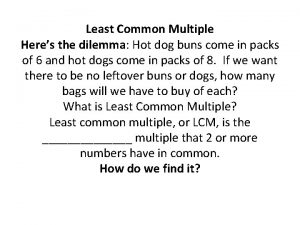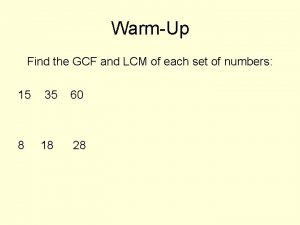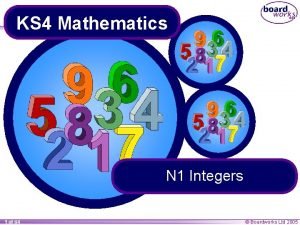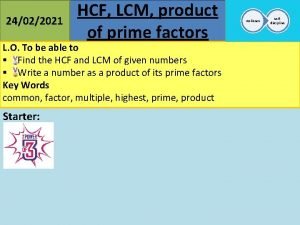HCF LCM Prime Factorisation Demonstration This resource provides












- Slides: 12

HCF & LCM – Prime Factorisation – Demonstration This resource provides animated demonstrations of the mathematical method. Check animations and delete slides not needed for your class.

Find the Highest Common Factor (HCF) & Lowest Common Multiple (LCM) of 12 & 20. 1) Complete Prime Factorisation for both numbers. 2 3 20 12 3 2 10 6 2 Shared Factors 20 12 2 2) Input the Prime Factors into a Venn diagram 2 5 3) HCF = Product of shared factors 2× 2 12 = 2 × 3 20 = 2 × 5 =4 4) LCM = Product of all factors in the diagram 2× 2× 3× 5 = 60

Find the Highest Common Factor (HCF) & Lowest Common Multiple (LCM) of 18 & 45. 1) Complete Prime Factorisation for both numbers. 3 3 45 18 2 3 15 9 3 Shared Factors 45 18 2 2) Input the Prime Factors into a Venn diagram 3 3 5 5 3) HCF = Product of shared factors 3× 3 18 = 2 × 3 45 = 3 × 5 =9 4) LCM = Product of all factors in the diagram 2× 3× 3× 5 = 90

Find the Highest Common Factor (HCF) & Lowest Common Multiple (LCM) of 24 & 36. 1) Complete Prime Factorisation for both numbers. 36 2 12 2 18 2 6 2 2 9 3 3 Shared Factors 36 24 24 2 2) Input the Prime Factors into a Venn diagram 3 2 2 3 3) HCF = Product of shared factors 2× 2× 3 24 = 2 × 2 × 3 36 = 2 × 3 × 3 3 = 12 4) LCM = Product of all factors in the diagram 2 × 2 × 3 = 72

Find the Highest Common Factor (HCF) & Lowest Common Multiple (LCM) of 75 & 90. 1) Complete Prime Factorisation for both numbers. Shared Factors 5 2 45 3 25 5 5 90 75 5 2) Input the Prime Factors into a Venn diagram 3 9 3 3 90 = 2 × 3 × 5 5 3 3) HCF = Product of shared factors 3× 5 75 = 3 × 5 2 = 15 4) LCM = Product of all factors in the diagram 2 × 3 × 5 = 450

Find the Highest Common Factor (HCF) & Lowest Common Multiple (LCM) of 20 & 30. 1) Complete Prime Factorisation for both numbers. 2) Input the Prime Factors into a Venn diagram 30 20 20 = 2 × 5 30 = 2 × 3 × 5 2 2 5 3) HCF = Product of shared factors 2× 5 = 10 4) LCM = Product of all factors in the diagram 2× 2× 3× 5 = 60 3

Find the Highest Common Factor (HCF) & Lowest Common Multiple (LCM) of 18 & 24. 1) Complete Prime Factorisation for both numbers. 2) Input the Prime Factors into a Venn diagram 24 18 18 = 2 × 3 24 = 2 × 2 × 3 2 3 3 3) HCF = Product of shared factors 2× 3 =6 4) LCM = Product of all factors in the diagram 2× 2× 2× 3× 3 = 72 2 2

Find the Highest Common Factor (HCF) & Lowest Common Multiple (LCM) of 120 & 150. 1) Complete Prime Factorisation for both numbers. 2) Input the Prime Factors into a Venn diagram 150 120 = 2 × 2 × 3 × 5 150 = 2 × 3 × 5 2 3 2 2 3) HCF = Product of shared factors 2× 3× 5 = 30 4) LCM = Product of all factors in the diagram 2× 2× 2× 3× 5× 5 = 600 5 5

Find the Highest Common Factor (HCF) & Lowest Common Multiple (LCM) of 63 & 210. 1) Complete Prime Factorisation for both numbers. 2) Input the Prime Factors into a Venn diagram 210 63 63 = 3 × 7 210 = 2 × 3 × 5 × 7 3 3 2 7 3) HCF = Product of shared factors 3× 7 = 21 4) LCM = Product of all factors in the diagram 2× 3× 3× 5× 7 = 630 5

1) Complete Prime Factorisation for both numbers. 18 = 2 × 3 24 = 2 × 2 × 3 2) Input the Prime Factors into a Venn diagram 24 18 2 3 3) HCF = Product of shared factors 2× 3 4) LCM = Product of all factors in the diagram 2× 2× 2× 3× 3 3 2 2 =6 = 72 Find the Highest Common Factor (HCF) & Lowest Common Multiple (LCM) of these pairs of numbers. HCF = a) 20 & 30 LCM = a) 54 & 36 a) 80 & 300 b) 12 & 40 HCF = LCM = b) 80 & 24 b) 12 & 18 & 90 c) 18 & 45 HCF = LCM = c) 90 & 150 c) 80 & 150 & 180

1) Complete Prime Factorisation for both numbers. 18 = 2 × 3 24 = 2 × 2 × 3 2) Input the Prime Factors into a Venn diagram 24 18 2 3 3) HCF = Product of shared factors 2× 3 4) LCM = Product of all factors in the diagram 2× 2× 2× 3× 3 3 2 2 =6 = 72 Find the Highest Common Factor (HCF) & Lowest Common Multiple (LCM) of these pairs of numbers. HCF = 10 a) 20 & 30 LCM = 60 b) 12 & 40 HCF = 4 LCM = 120 c) 18 & 45 HCF = 9 LCM = 90 HCF = 18 a) 54 & 36 LCM = 108 a) 80 & 300 HCF = 20 LCM = 1200 b) 80 & 24 HCF = 8 LCM = 240 b) 12 & 18 & 90 c) 90 & 150 HCF = 30 LCM = 450 c) 80 & 150 & 180 HCF = 6 LCM = 180 HCF = 10 LCM = 3600

Questions? Comments? Suggestions? …or have you found a mistake!? Any feedback would be appreciated . Please feel free to email: tom@goteachmaths. co. uk
 Hcf and lcm worksheet
Hcf and lcm worksheet Hcf of 90
Hcf of 90 Find hcf by prime factorisation method worksheet
Find hcf by prime factorisation method worksheet Write 56 as a product of its prime factors.
Write 56 as a product of its prime factors. The hot dog buns dilemma answers
The hot dog buns dilemma answers Lcm problems
Lcm problems Hcf questions
Hcf questions How to find lcm with venn diagram
How to find lcm with venn diagram Hcf example
Hcf example How to teach hcf and lcm
How to teach hcf and lcm Jeff bezos prime video prime
Jeff bezos prime video prime Solve quadratic equations by completing the square
Solve quadratic equations by completing the square Mind map of quadratic equation
Mind map of quadratic equation




















